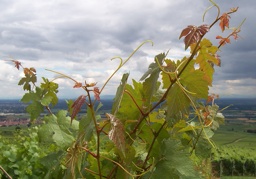
Muscat of Alsace
Two of a kind
In Alsace, Muscat is not one single variety but two. The oldest, and the most noble, is Muscat á petis grains. The other one is Muscat ottonnel, which is of much more recent origin and said to have its origin in Loire. In total, the two Muscats cover a mere 3% of the total vitucultural area.
To add to the confusion, Muscat á petis grains is often called Muscat d´Alsace.
Muscat á petis grains is one of the worlds oldest grapes. It is grown all across the Old World and it uses for raisins, as a dessert fruit and wines of many styles. It is very popular around the Mediterranian Sea where is was well established in the ancient Greek, Roman and Fenician cultures. Today is the basis for the sweet wines of Frontignan and Rivesaltes. Further east, Piedmont offers the seducing Moscato d´Asti.
Not always a green grape
Muscat á petis grains, is not always a green grape. Because it is genetically very unstable it gives birth to mutants. It also leads to wide variation in colour, where the mature grapes may attain every shade between pale yellow and chestnut red. It is not uncommon with a trace of pink in a Muscat wine.
Muscat is sensitive and is a loved diet by insects, birds and – tourists!
Muscat is generally picked first of all grapes for AOC Alsace wines. In 2003, some growers rescued their Muscat by starting the harvest on August 26. If the grapes are perfectly sound with no trace of rot, extra character can be attained by maceration up to 12 hours in the press prior to pressing, as practiced by Hugel in 2004.
In the vineyard, Muscat is recognized on the redish shoots (shown below).
 In the of the 19th century, the Muscat Ottonel, probably a crossing between Casselat and some local Muscat from the Loire. It matures before Muscat á petis grains and gives a secure harvest.The drawback of Muscat ottonel is that it has a very short flowering season.
In the of the 19th century, the Muscat Ottonel, probably a crossing between Casselat and some local Muscat from the Loire. It matures before Muscat á petis grains and gives a secure harvest.The drawback of Muscat ottonel is that it has a very short flowering season.
Since Muscat á petis grains give aroma and acidity while Muscat ottonel has the body, most Muscat sold is a mix in the range 1/3-2/3 either way. A brilliant exception is the Muscat Grand Cru Kirchberg from André Kientzler which is 100% Muscat á petis grains.
A romantic aroma
Muscat wines are characterized by a fresh, fruit grapy character where you will finns some white peppar, grape seed, roses, mint (from the Muscat á petis grains) and, most obiously, the aroma of freshly crushed grapes. The taste is totally dry, the body is light-weight and the fruitiness is much less than indicated by the nose.
Muscat is a charmer, inexcusably neglected by the public.
Muscat from Alsace is the perfect aperitif on a summer night. The light, fresh and romantic aroma triggers a relaxed and intimate atmosphere
It is the perfect match with asparagus and a sauce hollandaise, charged with fine strips of lemon peel. This tangy sauce, which holds some 80% fat, brings out the nuances in the asparagus and makes the Muscat wines unfold. The tale is that Muscat goes well with asparagus, but the most important is that asparagus and hollandaise brings out the best of the wine!
Try a Muscat with light Thai food with lemon grass, or fromages blancs with fresh herbs.
A light-weight champion
Muscat is sensitive variety that should be picked early to retain its fingerprint grape aroma. Few growers make VT or SGN from Muscat. As it thrives best well protected from the western rains, villages such as Voegtlinshoffen and Geuberschwihr are famous for their Muscat from Hatchbourg and Goldert. Another village for Muscat is Mittelwihr, where Edgar Schaller and others make wonderful examples.
Finally one must mention Bruno Sorgs focused Pfersigberg (Eguisheim), the floral Brand from Armand Hurst (Turckheim), Christian Binners ecological superstars (Ammerschwihr), Rolly-Gassmanns richer range (Rorschwihr) and the beauties of the north by Etienne Loew (Westhoffen).
Must weight g/liter |
Potential alcohol % |
|
| AOC Alsace | 144 | 8.5% |
AOC Alsace Grand Cru |
185 |
11% |
| Vendanges tardives | 236 | 14% |
Sélections de grains nobles |
276 |
16.4% |